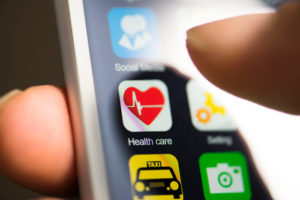Quandary: How to ensure safety and effectiveness without stifling innovation
 With some 165,000 health-related apps available for Apple or Android smartphones, the U.S. Food and Drug Administration has its hands full ensuring that they – and other digital health innovations – are safe and effective. In a newly unveiled “Digital Health Innovation Plan,” FDA Commissioner Scott Gottlieb, M.D. suggested how the agency intends to encourage safe and effective innovation without stifling new technology.
With some 165,000 health-related apps available for Apple or Android smartphones, the U.S. Food and Drug Administration has its hands full ensuring that they – and other digital health innovations – are safe and effective. In a newly unveiled “Digital Health Innovation Plan,” FDA Commissioner Scott Gottlieb, M.D. suggested how the agency intends to encourage safe and effective innovation without stifling new technology.
Innovative digital technologies have the power to transform healthcare in many ways, said Gottlieb in a recent blog:
- Empower consumers to make more and better decisions every day about their own health through fitness, nutrition and wellness monitoring.
- Enable better clinical practice and decision-making through decision-support software, to help providers make accurate diagnoses and develop treatment options.
- Help address public health crises, such as the opioid epidemic that is affecting many American communities.
“To encourage innovation, FDA should carry out its mission to protect and promote the public health through policies that are clear enough for developers to apply them on their own, without having to seek out, on a case-by-case basis, FDA’s position on every individual technological change or iterative software development,” he said.
Congress has already taken a major step to advance these goals in the 21st Century Cures Act, Gottlieb said. Expanding upon policies advanced by FDA’s Center for Devices and Radiological Health (CDRH), the Act revised FDA’s governing statute to make clear that certain digital health technologies – such as clinical administrative support software and mobile apps that are intended only for maintaining or encouraging a healthy lifestyle – fall outside the scope of FDA regulation. Such technologies tend to pose low risk to patients but can provide great value to the healthcare system, said Gottlieb.
“FDA will provide guidance to clarify our position on products that contain multiple software functions, where some fall outside the scope of FDA regulation, but others do not,” he said. “In addition, FDA will provide new guidance on other technologies that, although not addressed in the 21st Century Cures Act, present low enough risks that FDA does not intend to subject them to certain premarket regulatory requirements. Greater certainty regarding what types of digital health technology is subject to regulation and regarding FDA’s compliance policies will not only help foster innovation, but also will help the agency devote more resources to higher risk priorities.”
The FDA is also considering whether and how it can create a third-party certification program under which lower-risk digital health products could be marketed without FDA premarket review, and higher-risk products could be marketed with a streamlined FDA premarket review, Gottlieb said. “Certification could be used to assess, for example, whether a company consistently and reliably engages in high-quality software design and testing (validation) and ongoing maintenance of its software products. Employing a unique precertification program for software as a medical device (SaMD) could reduce the time and cost of market entry for digital health technologies.
“In addition, post-market collection of real-world data might be able to be used to support new and evolving product functions.
